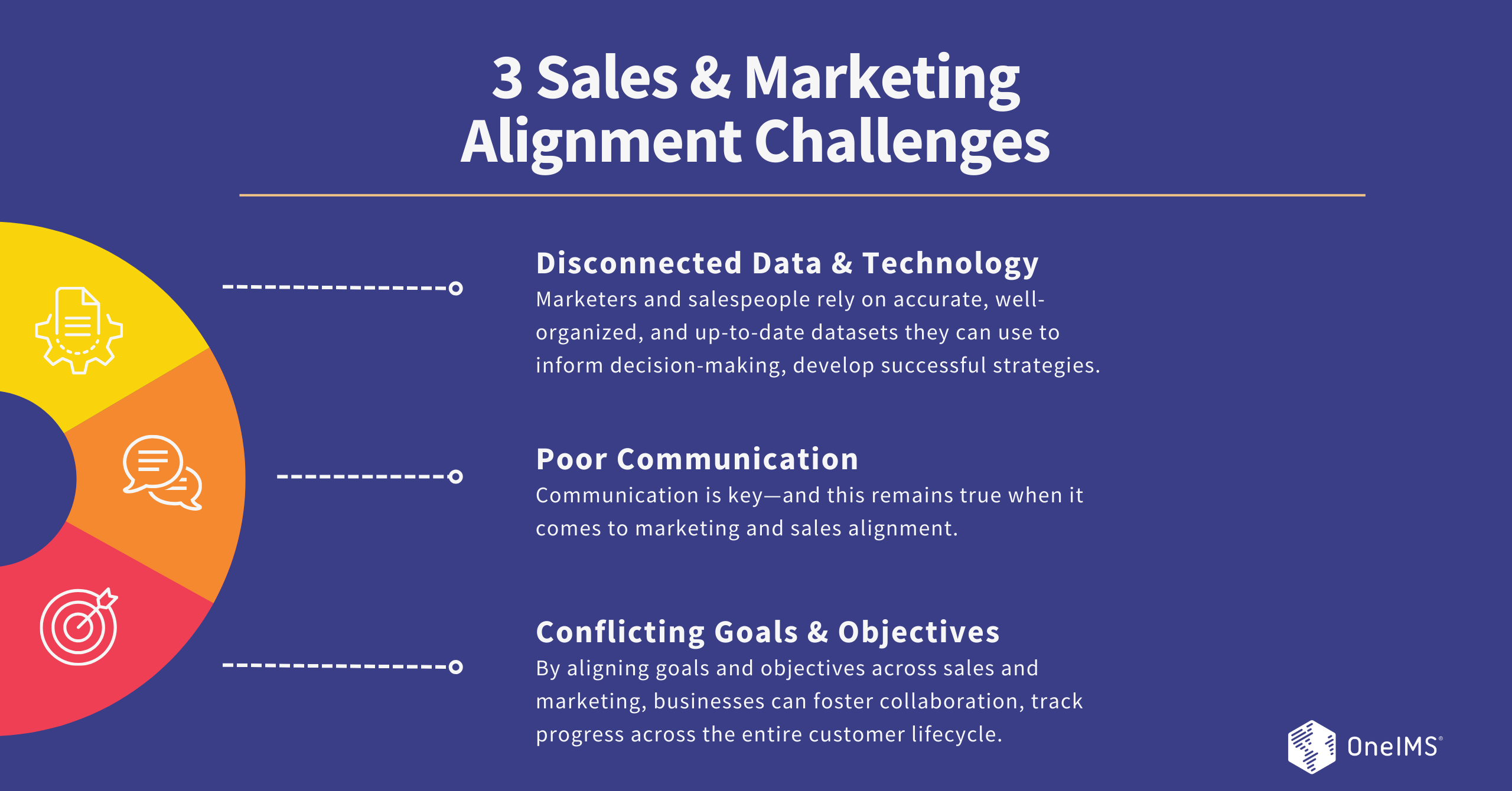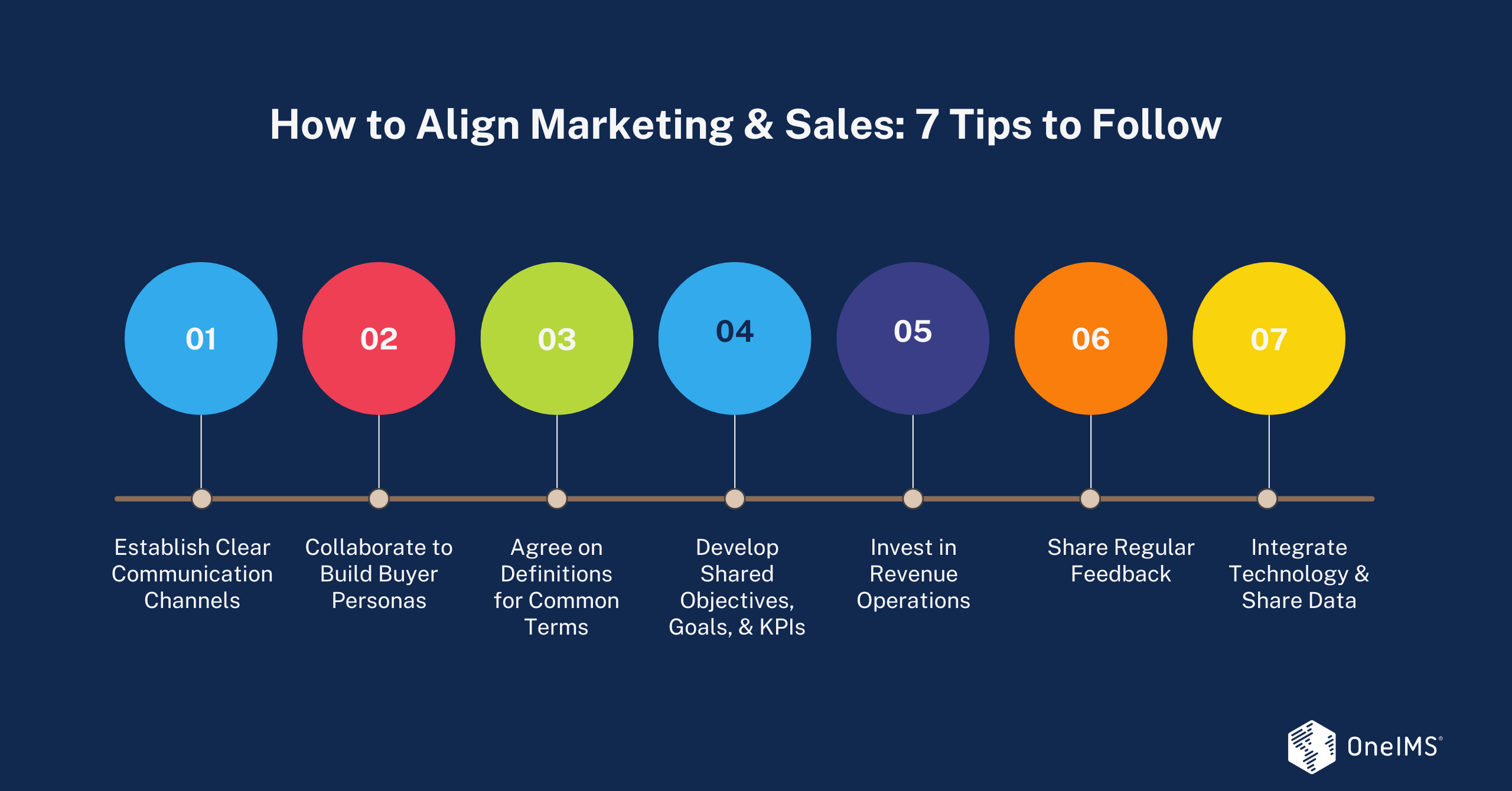Do your marketing and sales teams collaborate, communicate, and work together seamlessly to achieve shared goals?
Or are these departments siloed, isolated, and constantly butting heads?
Misalignment between sales and marketing teams has been a long-standing problem across business-to-business (B2B) companies and industries. However, as buyers change their purchasing habits and the B2B sales process becomes more complex, business success relies on both marketing and sales coming together to engage customers at every stage of the bow tie funnel.
Let’s take a closer look at how sales and marketing alignment can benefit your B2B organization.
What Is Sales and Marketing Alignment?
Sales and marketing alignment is the point at which these two teams are united around shared goals, technology, strategies, and communication. To successfully align sales and marketing departments, businesses must enable these independent groups to work as one cohesive whole.
True alignment between marketing and sales can lead to dramatic productivity, increased revenue growth, and improved return on investment (ROI).
The Importance of Sales & Marketing Alignment
What happens when sales and marketing aren’t aligned?
Nothing good: In the US, a lack of coordination between marketing and sales wastes an estimated $1 trillion every year.
But what about when sales and marketing are aligned?
The numbers show tangible benefits. Companies that align people, processes, and platforms across their marketing and sales teams achieve 36% more revenue growth, and highly aligned companies are 72% more profitable than their peers.
Aligning these two teams leads to more efficient internal workflows and communication, a better, more consistent customer experience, a shorter sales cycle, improved efficiency, and increased revenue growth. That means B2B companies without sales and marketing alignment are working at a disadvantage
How Can Alignment Between Marketing and Sales Drive KPIs?
When B2B sales and marketing teams are aligned, they are more likely to reach optimal results, achieve shared goals, and drive key performance indicators (KPIs).
By collaborating on KPIs, agreeing on objectives, tracking cross-departmental metrics, and eliminating internal friction, both marketing and sales teams will have the support they need to achieve.
3 Sales & Marketing Alignment Challenges
There are a few obstacles that often cause B2B companies to stumble in their plans to align their sales and marketing teams. Each of the challenges in these three critical areas can be addressed and overcome by following the right alignment strategy.
Disconnected Data & Technology
Marketers and salespeople rely on accurate, well-organized, and up-to-date datasets they can use to inform decision-making, develop successful strategies, and create seamless workflows. The marketing team uses marketing automation tools and data management platforms to function effectively, and sales representatives rely on customer relationship management (CRM) platforms to organize and access customer data.
If these technologies and datasets are disconnected, data is inaccessible and there is a disjointed flow of information between platforms. Integrating tech stacks and allowing relevant members of both teams to access the same data will ensure there is a single source of truth and that operations run smoothly.
Poor Communication
Communication is key—and this remains true when it comes to marketing and sales alignment.
Poor communication halts collaboration, disrupts learning opportunities, and makes it more difficult to work together to achieve shared goals.
Effective communication is the foundation of successful alignment between any two groups, including sales and marketing teams. From leaders and upper management to those working on the front lines, all members of each department must be able to join the conversation. Meeting regularly and using communication technologies can also help bridge the gap between these teams.
Conflicting Goals & Objectives
Marketing teams have their own goals, usually long-term ones like increasing brand awareness, generating more leads, and driving organic traffic. Sales teams, on the other hand, tend to aim for short-term goals like making deals, decreasing customer acquisition cost (CAC), and increasing win rates.
Unfortunately, these goals can often conflict. For example, the marketing team may successfully increase the number of leads they generate and pass along to sales reps, but if those additional leads don’t convert, they inhibit the ability of the sales team to reach their goals.
By aligning goals and objectives across sales and marketing, businesses can foster collaboration, track progress across the entire customer lifecycle, and work to achieve the same organizational revenue goals.
How to Align Marketing & Sales: 7 Tips to Follow
Effectively aligning your sales and marketing teams requires careful planning, but once you get on the right track, you will be on the path to long-term success. Follow these tips to get started on the sales and marketing alignment process for your B2B company.
Establish Clear Communication Channels
Make it easy for marketers and salespeople to collaborate, discuss, and share relevant information by establishing clear channels for regular communication. If your organization uses a messaging app like Slack or Microsoft teams, consider creating a shared channel dedicated to conversations among sales and marketing team members. Additionally, set consistent meetings between sales and marketing to avoid isolation and prioritize connection.
These avenues ensure both teams stay on the same page and are working toward the same goals.
Collaborate to Build Buyer Personas
Buyer personas are essential tools for both sales representatives and B2B marketers. They represent your ideal customer and are based on extensive target audience research.
Your marketing and sales staff can add valuable perspectives because of their deep, front-line experience with your customers. Develop buyer personas (and negative buyer personas) collaboratively with your sales and marketing teams to not only create more accurate personas but also encourage both groups to use them.
Agree on Definitions for Common Terms
What are marketing qualified leads (MQLs)? What are sales qualified leads (SQLs)? When is a lead ready to be passed on from marketing to sales, and what should that process look like?
Establish definitions of terms commonly used by both marketing and sales and ensure these teams agree on what they mean. It sounds like a simple tip, but a surprising number of B2B companies don’t take the time to formally agree on the use of these (and other) terms organization-wide. Using the same shared vocabulary will eliminate many communication and workflow obstacles and make sure both teams are starting from the same common ground.
Too often, sales and marketing teams have misaligned goals, conflicting objectives, and inconsistent KPIs and success metrics—which lead to inefficiencies, a lack of cross-departmental collaboration, and ineffective ROI analysis.
When marketing and sales have shared objectives, goals, and KPIs, they develop a unified focus, are encouraged to collaborate, and use the same measures of success. Have marketing and sales leadership work together to define common objectives, performance metrics, and revenue goals to make sure efforts across both teams are synchronized.
Invest in Revenue Operations
As marketing and sales alignment is a cornerstone of revenue operations (RevOps), it’s no surprise that implementing RevOps improves collaboration and unites the objectives of these teams. In fact, after investing in a RevOps function, 21% of companies saw increases in alignment and productivity across marketing, sales, and customer success.
There is a wide range of benefits that come hand in hand with following a RevOps framework—from a streamlined customer experience and improved processes to scalable personalization and predictable business growth—but one of the most important advantages of this methodology is the most efficient way to achieve true alignment.
After establishing open communication channels and creating opportunities to share information, your marketing and sales teams can start sharing feedback to make each other more productive.
Marketers create brochures, presentations, sales enablement content, and more to support sales efforts. Do your salespeople find those deliverables valuable? How can they be improved? They also send MQLs to sales. Are they what the sales team is looking for? What can marketing do to better qualify leads?
Sales representatives get a firsthand look at how prospects become customers. What information and data could sales pass to marketing? How can the sales team use marketing assets more effectively?
Encourage your sales and marketing teams to share regular feedback to drive continuous improvement.
Simplify data sharing, streamline information flow, and encourage collaboration by integrating technology across marketing and sales. By working with aligned platforms and software, these teams can more easily share insights, collaborate on projects, and learn from each other.
Integrating the sales and marketing tech stack should also include setting standardized approaches to collecting, organizing, and using data. Ensure consistency across teams, eliminate redundancies, and reduce errors by establishing a centralized database.
Conclusion
United we stand, divided we fall. That old adage is still relevant, even in the ever-changing and competitive B2B landscape.
Marketing and sales alignment is key to the long-term success of your B2B company. Through communication, collaboration, and connection, your sales and marketing teams will be equipped to work together to achieve common goals—like increasing revenue and establishing predictable business growth.
Need help fostering alignment across departments, generating more revenue, and growing your business? We’re ready to partner with you. Schedule a consultation with us today to get started.




































